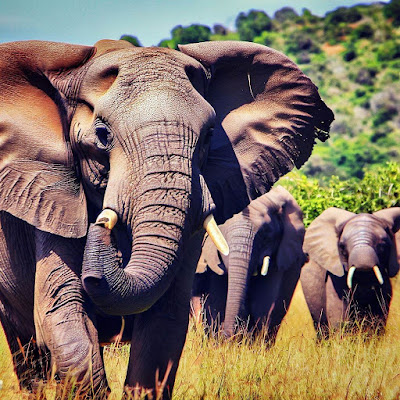The African Elephant: Majestic Guardians of the Savanna
🟩Introduction :
Embark on a journey to the vast plains of Africa, where an iconic symbol of strength, intelligence, and grace roams majestically—the African Elephant. As we delve into the enchanting world of these magnificent creatures, we discover their unparalleled size, intricate social structures, and vital role in maintaining the delicate balance of their ecosystem. Join us as we unveil the splendor and significance of the largest land animal on Earth.
🟨Description :
The African Elephant (Loxodonta africana and Loxodonta cyclotis) stands tall as the embodiment of wilderness and power, commanding both respect and awe. With an average height of 10 to 13 feet (3 to 4 meters) at the shoulder and weighing an astonishing 5,000 to 14,000 kilograms, these gentle giants hold the title of the largest land-dwelling mammals on the planet.
Draped in grayish-brown wrinkled skin, the African Elephant displays an intricate network of complex social structures within its herds. Led by wise matriarchs, these herds consist of females and their offspring, while males lead a solitary existence or form small bachelor groups. The remarkable bond between members of the herd is evident in their cooperation, communication, and collective nurturing of the young.
One of the most distinctive features of the African Elephant is its remarkable tusks. These elongated incisor teeth can grow up to 10 feet (3 meters) in length and serve various purposes. While they are primarily used for digging, foraging, and stripping bark from trees, they can also be deployed as weapons to protect the herd or establish dominance within their ranks. Unfortunately, the allure of ivory has placed these magnificent creatures at risk, leading to illegal poaching and endangering their population.
The African Elephant's diet consists mainly of grass, leaves, fruits, and bark. In search of sustenance, they traverse vast distances, transforming the landscape as they navigate the savanna. With their trunks, which are elongated muscular organs capable of great dexterity, they manipulate objects, feed themselves, and display emotions. The trunk is also used as a powerful tool for communication, emitting a variety of sounds, such as trumpets, rumbles, and deep purrs, conveying messages across the plains.
These gentle giants have a profound impact on their ecosystem, shaping the landscape through their feeding habits. By uprooting trees, creating water holes, and dispersing seeds through their dung, they contribute to the overall biodiversity and survival of countless other species. They are, in essence, the architects of their habitat, ensuring a delicate equilibrium that benefits not only themselves but also the entire ecosystem they call home.
🟦Ending :
As our exploration of the African Elephant comes to a close, we are left with a deep appreciation for these remarkable creatures. Through their majestic presence and integral role in maintaining the balance of the African savanna, they inspire awe and reverence. Let us stand as guardians of their existence, working collectively to protect their habitats and preserve the rich tapestry of life they represent. The African Elephant, a true testament to nature's magnificence, remains an enduring symbol of our responsibility to cherish and safeguard the wonders of our planet
🟨Description :
Draped in grayish-brown wrinkled skin, the African Elephant displays an intricate network of complex social structures within its herds. Led by wise matriarchs, these herds consist of females and their offspring, while males lead a solitary existence or form small bachelor groups. The remarkable bond between members of the herd is evident in their cooperation, communication, and collective nurturing of the young.
One of the most distinctive features of the African Elephant is its remarkable tusks. These elongated incisor teeth can grow up to 10 feet (3 meters) in length and serve various purposes. While they are primarily used for digging, foraging, and stripping bark from trees, they can also be deployed as weapons to protect the herd or establish dominance within their ranks. Unfortunately, the allure of ivory has placed these magnificent creatures at risk, leading to illegal poaching and endangering their population.
The African Elephant's diet consists mainly of grass, leaves, fruits, and bark. In search of sustenance, they traverse vast distances, transforming the landscape as they navigate the savanna. With their trunks, which are elongated muscular organs capable of great dexterity, they manipulate objects, feed themselves, and display emotions. The trunk is also used as a powerful tool for communication, emitting a variety of sounds, such as trumpets, rumbles, and deep purrs, conveying messages across the plains.
These gentle giants have a profound impact on their ecosystem, shaping the landscape through their feeding habits. By uprooting trees, creating water holes, and dispersing seeds through their dung, they contribute to the overall biodiversity and survival of countless other species. They are, in essence, the architects of their habitat, ensuring a delicate equilibrium that benefits not only themselves but also the entire ecosystem they call home.
🟦Ending :
As our exploration of the African Elephant comes to a close, we are left with a deep appreciation for these remarkable creatures. Through their majestic presence and integral role in maintaining the balance of the African savanna, they inspire awe and reverence. Let us stand as guardians of their existence, working collectively to protect their habitats and preserve the rich tapestry of life they represent. The African Elephant, a true testament to nature's magnificence, remains an enduring symbol of our responsibility to cherish and safeguard the wonders of our planet


Comments